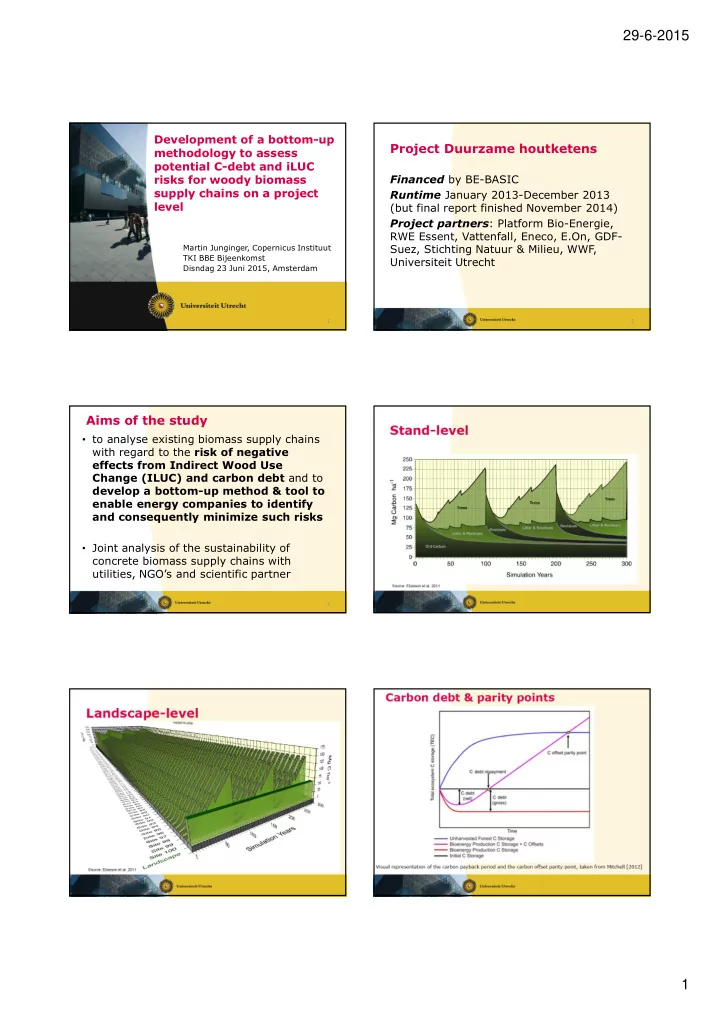

29-6-2015 Development of a bottom-up Project Duurzame houtketens methodology to assess potential C-debt and iLUC risks for woody biomass Financed by BE-BASIC supply chains on a project Runtime January 2013-December 2013 level (but final report finished November 2014) Project partners : Platform Bio-Energie, RWE Essent, Vattenfall, Eneco, E.On, GDF- Martin Junginger, Copernicus Instituut Suez, Stichting Natuur & Milieu, WWF, TKI BBE Bijeenkomst Universiteit Utrecht Disndag 23 Juni 2015, Amsterdam 1 2 Aims of the study • to analyse existing biomass supply chains with regard to the risk of negative effects from Indirect Wood Use Change (ILUC) and carbon debt and to develop a bottom-up method & tool to enable energy companies to identify and consequently minimize such risks • Joint analysis of the sustainability of concrete biomass supply chains with utilities, NGO’s and scientific partner 3 4 5 6 1
29-6-2015 7 8 9 10 11 12 2
29-6-2015 13 14 15 16 17 18 3
29-6-2015 Example result: forest residues Scoring for each criterion from boreal forest The score for each C-debt and ILUC/IWUC criterion is In Canada, using slash to produce pellets to replace coal in • • determined by one or several indicators. Scores can vary the Netherlands from 1 (low risk) to 5 (high risk), in some case can also be Carbon debt risk: 1,0 0, or can be blank (i.e. not applicable) Carbon Stock change due to harvest 2,4 Speed of carbon accumula�on(a er harvest) For C-debt, we also included the option to calculate a • 1,0 single, total score, i.e. a geometrical average of the scores Reference forest system (wood / land use) for the criteria. Note that if one of the C-debt criteria has a Regional forest carbon stock reference score of 0 the entire score becomes zero (e.g. if 2,0 Reference Energy system counterfactual for residues is burning in the field) Aggregate score not done for ILUC/IWUC 1,5 Total score • ILUC/ IWUC risk: Current risk, reference year: 2013 Future risk, reference year: 2020 General risk level (land scarcity) in the region 19 20 HYPOTHETICAL EXAMPLE: pulp quality trees from Nordic pine plantation Assuming that the alternative reference scenario would be • that the plantation is left to grow further for another 30 years (NOT realistic / current practice) Carbon debt risk: 3,0 Carbon Stock change due to harvest 2,6 Speed of carbon accumula�on(a er harvest) 5,0 Reference forest system (wood / land use) Regional forest carbon stock reference 2,0 Reference Energy system 3,0 Total score ILUC/ IWUC risk: 0,0 Current risk, reference year: 2013 3,5 Future risk, reference year: 2020 General risk level (land scarcity) in the region 21 22 Follow-up (?) • Next to further methodological improvements, real case studies should be carried out to test the tool in practice • C-Debt and IWUC are in the current SER negotiations assessed by a (much) simpler rule: a maximum share of woody biomass can be used for energy purposes, the rest needs to be used for material purposes • Current tool could still be a useful addition to identify possible risks on a individual mill level 23 24 4
29-6-2015 Questions and Feedback Martin Junginger h.m.junginger@uu.nl 25 5
Recommend
More recommend